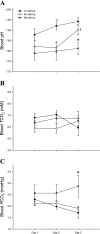Ca2+-driven intestinal HCO(3)(-) secretion and CaCO3 precipitation in the European flounder in vivo: influences on acid-base regulation and blood gas transport
- PMID: 20130227
- PMCID: PMC2853387
- DOI: 10.1152/ajpregu.00513.2009
Ca2+-driven intestinal HCO(3)(-) secretion and CaCO3 precipitation in the European flounder in vivo: influences on acid-base regulation and blood gas transport
Abstract
Marine teleost fish continuously ingest seawater to prevent dehydration and their intestines absorb fluid by mechanisms linked to three separate driving forces: 1) cotransport of NaCl from the gut fluid; 2) bicarbonate (HCO(3)(-)) secretion and Cl(-) absorption via Cl(-)/HCO(3)(-) exchange fueled by metabolic CO(2); and 3) alkaline precipitation of Ca(2+) as insoluble CaCO(3), which aids H(2)O absorption). The latter two processes involve high rates of epithelial HCO(3)(-) secretion stimulated by intestinal Ca(2+) and can drive a major portion of water absorption. At higher salinities and ambient Ca(2+) concentrations the osmoregulatory role of intestinal HCO(3)(-) secretion is amplified, but this has repercussions for other physiological processes, in particular, respiratory gas transport (as it is fueled by metabolic CO(2)) and acid-base regulation (as intestinal cells must export H(+) into the blood to balance apical HCO(3)(-) secretion). The flounder intestine was perfused in vivo with salines containing 10, 40, or 90 mM Ca(2+). Increasing the luminal Ca(2+) concentration caused a large elevation in intestinal HCO(3)(-) production and excretion. Additionally, blood pH decreased (-0.13 pH units) and plasma partial pressure of CO(2) (Pco(2)) levels were elevated (+1.16 mmHg) at the highest Ca perfusate level after 3 days of perfusion. Increasing the perfusate [Ca(2+)] also produced proportional increases in net acid excretion via the gills. When the net intestinal flux of all ions across the intestine was calculated, there was a greater absorption of anions than cations. This missing cation flux was assumed to be protons, which vary with an almost 1:1 relationship with net acid excretion via the gill. This study illustrates the intimate link between intestinal HCO(3)(-) production and osmoregulation with acid-base balance and respiratory gas exchange and the specific controlling role of ingested Ca(2+) independent of any other ion or overall osmolality in marine teleost fish.
Figures




Similar articles
-
Osmoregulation and epithelial water transport: lessons from the intestine of marine teleost fish.J Comp Physiol B. 2012 Jan;182(1):1-39. doi: 10.1007/s00360-011-0601-3. Epub 2011 Jul 7. J Comp Physiol B. 2012. PMID: 21735220 Review.
-
HCO (3)(-) secretion and CaCO3 precipitation play major roles in intestinal water absorption in marine teleost fish in vivo.Am J Physiol Regul Integr Comp Physiol. 2010 Apr;298(4):R877-86. doi: 10.1152/ajpregu.00545.2009. Epub 2010 Feb 3. Am J Physiol Regul Integr Comp Physiol. 2010. PMID: 20130226 Free PMC article.
-
Intestinal bicarbonate secretion in marine teleost fish-source of bicarbonate, pH sensitivity, and consequences for whole animal acid-base and calcium homeostasis.Biochim Biophys Acta. 2003 Dec 30;1618(2):163-74. doi: 10.1016/j.bbamem.2003.09.014. Biochim Biophys Acta. 2003. PMID: 14729153
-
Intestinal bicarbonate secretion by marine teleost fish--why and how?Biochim Biophys Acta. 2002 Nov 13;1566(1-2):182-93. doi: 10.1016/s0005-2736(02)00600-4. Biochim Biophys Acta. 2002. PMID: 12421549 Review.
-
Acid-base regulation in the plainfin midshipman (Porichthys notatus): an aglomerular marine teleost.J Comp Physiol B. 2010 Nov;180(8):1213-25. doi: 10.1007/s00360-010-0492-8. Epub 2010 Jun 23. J Comp Physiol B. 2010. PMID: 20571812
Cited by
-
Water absorption and bicarbonate secretion in the intestine of the sea bream are regulated by transmembrane and soluble adenylyl cyclase stimulation.J Comp Physiol B. 2012 Dec;182(8):1069-80. doi: 10.1007/s00360-012-0685-4. Epub 2012 Jun 30. J Comp Physiol B. 2012. PMID: 22752677
-
Rapid blood acid-base regulation by European sea bass (Dicentrarchus labrax) in response to sudden exposure to high environmental CO2.J Exp Biol. 2022 Jan 15;225(2):jeb242735. doi: 10.1242/jeb.242735. Epub 2022 Jan 26. J Exp Biol. 2022. PMID: 35005768 Free PMC article.
-
Exogenous enzymes and probiotics alter digestion kinetics, volatile fatty acid content and microbial interactions in the gut of Nile tilapia.Sci Rep. 2021 Apr 15;11(1):8221. doi: 10.1038/s41598-021-87408-3. Sci Rep. 2021. PMID: 33859242 Free PMC article.
-
Osmoregulation and epithelial water transport: lessons from the intestine of marine teleost fish.J Comp Physiol B. 2012 Jan;182(1):1-39. doi: 10.1007/s00360-011-0601-3. Epub 2011 Jul 7. J Comp Physiol B. 2012. PMID: 21735220 Review.
-
Compensatory regulation of acid-base balance during salinity transfer in rainbow trout (Oncorhynchus mykiss).J Comp Physiol B. 2012 Feb;182(2):259-74. doi: 10.1007/s00360-011-0617-8. Epub 2011 Oct 12. J Comp Physiol B. 2012. PMID: 21989837
References
-
- Ando M, Subramanyam MVV. Bicarbonate transport systems in the intestine of the seawater eel. J Exp Biol 150: 381–394, 1990
-
- Berenbrink M. Historical reconstructions of evolving physiological complexity: O2 secretion in the eye and swimbladder of fishes. J Exp Biol 210: 1641–1652, 2007 - PubMed
-
- Berenbrink M, Koldkjaer P, Kepp O, Cossins AR. Evolution of oxygen secretion in fishes and the emergence of a complex physiological system. Science 307: 1752–1757, 2005 - PubMed
-
- Boutilier RG, Heming TA, Iwama GK. Appendix–physicochemical parameters for use in fish respiratory physiology. Fish Physiol 10: 403–430, 1984
Publication types
MeSH terms
Substances
Grants and funding
LinkOut - more resources
Full Text Sources
Miscellaneous

